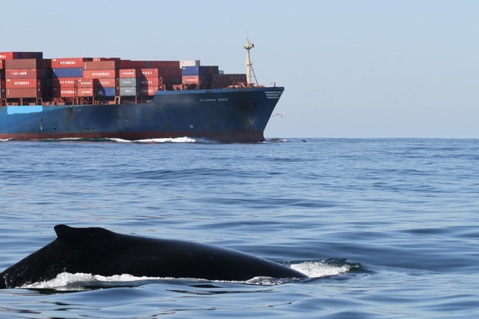A Whale of a Good Idea
Incentives Lower Ship Strikes and Air Pollution

When the Santa Barbara Foundation made its first round of innovative grants earlier this year, one of them fostered a “two-fer” that will not only help protect whales, but also improve the air we breathe. The “Safe Passage” project called for a pilot study to see if large container ships would accept incentives to reduce their speed going through the Santa Barbara Channel.
When ships transit at 12 knots or below, they dramatically lower the chance of a lethal strike on endangered whales that seasonally feed and migrate through the channel. Cruising at reduced speeds also saves fuel and reduces nitrogen oxides (NOx) that form pollutants harmful to humans, such as ozone. Shipping accounts for half the NOx emitted in the county and is also a significant source of other air pollutants such as sulfur dioxide, greenhouse gases, diesel particulate matter, and more.
The Environmental Defense Center (EDC), together with the Channel Islands National Marine Sanctuary (within the National Oceanic and Atmospheric Administration, or NOAA) and the Santa Barbara County Air Pollution Control District (APCD), had sought funding with four goals: 1) finding out whether the shipping industry would willingly participate, 2) refining ship data collection and tracking mechanisms, 3) assessing potential air pollution and whale protection benefits, and 4) laying the foundation to establish a larger scale program in the future.
The study, now well past the halfway mark, is yielding important data and a strong indication of industry cooperation. Six global shipping companies are participating. They identified ships in their fleets to transit between Point Conception and the Ports of Los Angeles and Long Beach between July and October at speeds of 12 knots or less (reduced from typical speeds of 14–18 knots). Participating companies will receive $2,500 per verified transit through the Santa Barbara Channel. To date, 11 transits have been completed. Data from the first four ships in the trial showed average speeds ranging from 7.59 to 11.79 knots.
Coming at the peak of blue whale feeding season, the trial is demonstrating the willingness of shipping companies to work with NOAA and environmental groups to lower their speed and the risk of deadly whale strikes. The trial is also providing important data for the APCD to calculate potential air quality improvements from reduced speeds and gain experience NOAA and the APCD need to consider an expanded program in the future.
The project demonstrates another milestone — progress in protecting whale populations and reducing pollution can result from cooperation between government agencies at the local and national level, industry, and environmentalists. This innovative program is testing the use of financial incentives rather than regulation to achieve big environmental gains — a whale of a good idea!
A community forum on the Safe Passage project will be held on September 10, 2014, from 3-5 p.m., at the Cabrillo Pavilion Arts Center in Santa Barbara.
Gail Osherenko is a project scientist at the Marine Science Institute at UCSB and a member of the Board of Directors of EDC.



